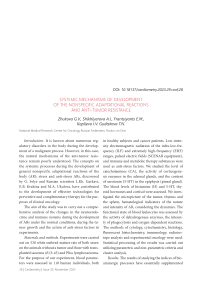Systemic mechanisms of development of the nonspecific adaptational reactions and anti-tumor resistance
Автор: Zhukova G.V., Shikhlyarova A.I., Frantsiyants E.M., Kaplieva I.V., Gudtskova T.N.
Журнал: Cardiometry @cardiometry
Рубрика: Conference proceedings
Статья в выпуске: 29, 2023 года.
Бесплатный доступ
It is known about numerous regulatory disorders in the body during the development of a malignant process. However, in this case, the natural mechanisms of the anti-tumor resistance remain poorly understood. The concepts on the systemic processes during the development of general nonspecific adaptational reactions of the body (AR): stress and anti-stress ARs, discovered by G. Selye and Russian scientists L.Kh. Garkavi, E.B. Kvakina and M.A. Ukolova, have contributed to the development of effective technologies for preventive and complementary therapy for the purposes of clinical oncology
Malignant tumors, adaptational reactions, biogenic amines, regulatory systems, anti-tumor effect
Короткий адрес: https://sciup.org/148327400
IDR: 148327400 | DOI: 10.18137/cardiometry.2023.29.conf.28
Текст статьи Systemic mechanisms of development of the nonspecific adaptational reactions and anti-tumor resistance
National Medical Research Centre for Oncology Russian Federation, Rostov-on-Don
Introduction . It is known about numerous regulatory disorders in the body during the development of a malignant process. However, in this case, the natural mechanisms of the anti-tumor resistance remain poorly understood. The concepts on the systemic processes during the development of general nonspecific adaptational reactions of the body (AR): stress and anti-stress ARs, discovered by G. Selye and Russian scientists L.Kh. Garkavi, E.B. Kvakina and M.A. Ukolova, have contributed to the development of effective technologies for preventive and complementary therapy for the purposes of clinical oncology.
The aim of the study was to carry out a comprehensive analysis of the changes in the neuroendocrine and immune systems during the development of ARs under the normal conditions, during the tumor growth and the action of anti-stress factors in experiments.
Materials and methods . Experiments were carried out on 530 white outbred mature rats of both sexes: on the animals without a tumor and those with transplanted sarcoma 45 (S-45) and Pliss lymphosarcoma. For the purpose of our experiment, blood parameters were assessed in 110 human individuals, both
36 | Cardiometry | Issue 29. November 2023
in healthy subjects and cancer patients. Low-intensity electromagnetic radiation of the infra-low-frequency (ILF) and extremely high-frequency (EHF) ranges, pulsed electric fields (SCENAR equipment), and immune and metabolic therapy substances were used as anti-stress factors. We studied the level of catecholamines (CA), the activity of corticogene-sis enzymes in the adrenal glands, and the content of serotonin (5-HT) in the epiphysis (pineal gland). The blood levels of histamine (H) and 5-HT, thyroid hormones and cortisol were assessed. We investigated the micropicture of the tumor, thymus and the spleen, hematological indicators of the nature and intensity of AR, considering the dynamics. The functional state of blood leukocytes was assessed by the activity of dehydrogenase enzymes, the intensity of phagocytosis and oxygen-dependent reactions. The methods of cytology, cytochemistry, histology, fluorescent histochemistry, immunology, radioisotope analysis and experimental oncology were used. Statistical processing of the results was carried out utilizing parametric and non-parametric criteria and cluster analysis.
Results. The results of studying the indices of bio-aminergic processes have essentially supplemented the understanding of the neuroendocrine mechanisms associated with the development of the AR of acute and chronic stress and the anti-stress AR of training, calm and elevated activation. Signs of activation of the 5-HTergic systems during the development of AR of calm and elevated activation and “switching-on” of the epiphyseal-adrenal system with a decrease in the level of reactivity of AR of elevated activation, as well as a decrease in the activity of the monoaminergic systems with the development of the persistent anti-stress AR have been revealed. Under the tumor growth, a disruption of the relationship between the BA level and the character of AR has been observed.
In case of the anti-tumor effectiveness of anti-stress factors, a partial recovery of the above relationship has been noted, associated with signs of pronounced activation of blood leukocytes, lymphoproliferative processes and intercellular interactions in the organs of the immune system, infiltration of tumor zones by immune cells with pronounced markers of their interaction with tumor cells. The adaptational reactions (AR) upon the impacts of high efficiency, as well as the changes in tumor-bearing animals with signs of a state of activation areac-tivity have been described.
Conclusion . The results obtained by us allowed us to formulate the concepts on the multi-level systemic regulatory processes during the development of AR and their influence on the state of nonspecific anti-tumor resistance by the body.


